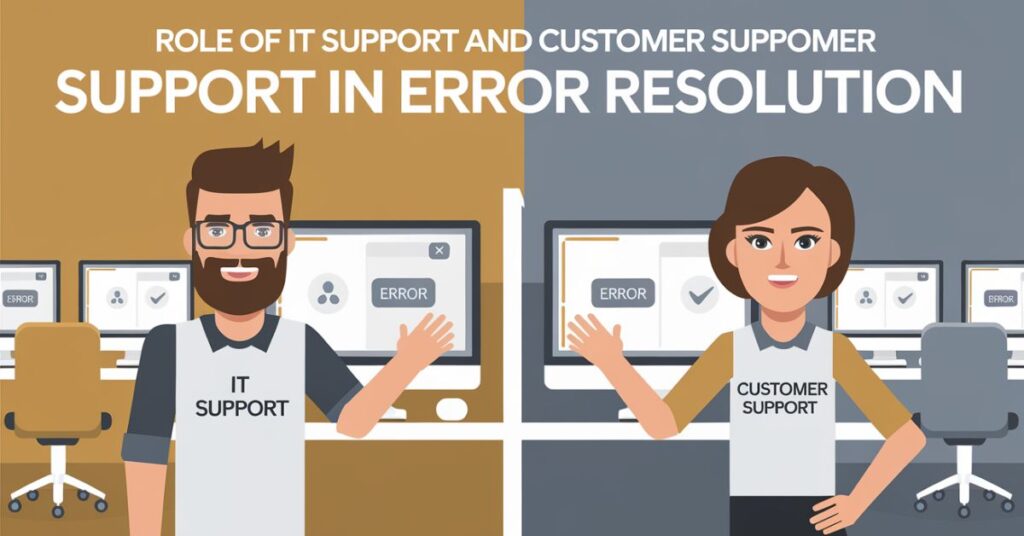Error Code FintechAsia refers to the specific codes generated by the FintechAsia platform when a problem occurs. These codes help identify issues in online transactions, authentication, or system processes. Each error code points directly to the problem, making it easier for users to troubleshoot.
Encountering errors while making financial transactions can be frustrating. Understanding Error Code FintechAsia can save time and reduce hassle for both businesses and users. Knowing what these codes mean allows quick fixes and keeps transactions flowing smoothly.
FintechAsia’s error codes are essential for a stable online experience. Common causes include incorrect information, system downtime, or network issues. By learning about these codes, users can handle issues confidently and efficiently.
What is the Error Code FintechAsia?
Error Code FintechAsia represents specific error codes within the FintechAsia platform that signal issues or disruptions in online financial processes. These codes appear when the system encounters problems like transaction failures, login issues, or processing errors. Each code provides details that help users and businesses understand and address the problem effectively, allowing for smoother operations and quicker troubleshooting.
Importance of Understanding Fintech Error Codes for Businesses and Consumers
Fintech error codes like those in FintechAsia play a crucial role in modern financial systems. For businesses, understanding these codes allows them to maintain seamless services, prevent disruptions, and address issues before they impact customers. Consumers benefit by knowing how to troubleshoot common issues, reducing frustration and building confidence in the fintech system. With the right knowledge, both parties can respond quickly to issues, ensuring efficient transactions and secure interactions within the platform.
Common Types and Causes of Error Code FintechAsia
Error codes on FintechAsia often fall into several types based on their root causes and severity. These include general errors (basic system malfunctions), transaction errors (issues during payment processes), authentication errors (login or credential issues), and system errors (technical faults). Each type has unique causes, such as server overloads, expired sessions, or connection issues, requiring specific solutions for timely resolution.
Common FintechAsia Error Codes and Their Variants (500, 404, 401)
FintechAsia encounters common error codes with specific meanings and resolutions:
| Error Code | Type | Description |
| 500 | Server Error | Indicates server issues or temporary unavailability |
| 404 | Not Found | Occurs when requested data or page is missing |
| 401 | Unauthorized | Indicates issues with login or credentials verification |
Each of these codes points to specific issues, making it easier for users to identify problems and take the necessary actions. These common codes reflect widely recognized internet standards, helping users understand errors across multiple platforms.
- Related Blog” Miracoup Drone Review: A Comprehensive Guide
Categories of FintechAsia Error Codes
General Error Codes
General error codes represent basic system malfunctions. They usually indicate system downtime, maintenance, or unexpected issues like 500 server errors. Users are often advised to wait briefly and retry the action or check for updates on the platform status.
Transaction Error Codes
Transaction error codes appear during payment or transfer processes, often related to insufficient funds, network connectivity, or processing delays. These errors signal issues directly tied to financial transactions and require specific actions for resolution.
Authentication Error Codes
Authentication error codes, like 401 (Unauthorised), occur when there are issues with login credentials or session timeouts. Resolving these typically involves verifying login details, resetting passwords, or confirming two-factor authentication.
System Error Codes
System error codes often signal deeper technical issues within FintechAsia’s platform, such as integration problems or software bugs. They may require IT intervention or software updates to resolve, as they impact the entire system’s functionality.
Common Causes of Error Codes in Fintech Platforms
System Overloads and Performance Issues
System overloads can cause error codes, especially when user demand exceeds server capacity. This overload results in slower responses or even system crashes. Fintech platforms need regular capacity assessments to manage user loads and prevent overload-related errors.
Software Compatibility Challenges
Incompatibility between software versions or operating systems can cause errors in fintech platforms. Regular updates, compatibility checks, and thorough testing help reduce these errors, ensuring smooth platform performance across devices and software versions.
Effects of Error Code FintechAsia on Financial Systems
Impact on Financial Technology Systems
Error codes disrupt operations and affect the efficiency of financial technology systems. These interruptions can delay transactions, complicate payments, and increase operational costs for companies if left unaddressed. Minimising these errors is essential for smooth fintech services.
Disruption of Online Banking and Stock Trading Platforms
Error codes in fintech systems can significantly impact online banking and stock trading platforms. Disruptions can prevent users from accessing accounts, making transactions, or tracking investments, which ultimately harms platform reliability and user satisfaction.
User Experience and Customer Retention
A frequent encounter with error codes leads to poor user experience, which affects customer loyalty and retention. Users expect seamless digital services, and consistent errors can result in loss of trust, prompting users to seek alternative platforms.
Troubleshooting and Resolving FintechAsia Error Codes
Successfully resolving FintechAsia error codes involves systematic troubleshooting to identify the problem. For common issues, users can follow specific steps like checking connectivity, updating software, and verifying credentials. For complex errors, customer support or IT intervention may be required to restore functionality.
Steps to Diagnose Fintech Errors
Solution 1: Check for Connectivity Issues
Ensure a stable internet connection before retrying any transaction. Poor connectivity can cause many error codes in fintech platforms.
Solution 2: Update Application or Software
Running outdated software can cause compatibility issues. Updating your application or software version can often resolve these errors.
Solution 3: Verify Account Details and Credentials
Incorrect login details can trigger authentication errors. Double-check your username, password, and any multi-factor authentication settings.
Solution 4: Clear Cache and Cookies
Old cache and cookies can cause platform loading issues. Clearing them refreshes the application’s performance and can resolve display errors.
Solution 5: Contact Customer Support
If the issue persists, reach out to customer support. They can offer insights or steps specific to the error code encountered.
Basic and Advanced Troubleshooting Techniques
Advanced troubleshooting might involve technical support, software reinstallations, or checking server status for server-side issues.
Role of IT Support and Customer Support in Error Resolution

When and How to Contact Support
Contacting support is essential when troubleshooting fails. The support team can provide targeted solutions based on the error encountered.
How to Contact Support
Users can typically reach FintechAsia support via the support page, email, or phone hotline. Having error codes and details on hand will expedite the assistance process.
The Role of FintechAsia Customer Support in Resolving Errors
FintechAsia’s customer support plays a vital role in addressing user issues. Their support team offers personalised troubleshooting and advice for complex errors beyond user control.
Case Studies and Real-World Examples
Examples of Companies Overcoming Fintech Errors
Real-world cases show how fintech companies effectively handle error codes to minimize downtime. For example, some companies implement server upgrades to manage traffic surges.
Case Study 1: Resolving Error Code 502 by Increasing Server Capacity
In this example, a financial platform mitigated Error Code 502 by increasing server capacity, reducing disruptions during high traffic periods.
Case Study 2: Resolving Error Code 404 through Customer Support
Another case involved resolving Error Code 404 through effective customer support, which guided users to correct information paths and reduced navigation errors.
- Related Blog” Cash App NFC Tag Setup: Fast & Easy Payments
Preventive Measures and Best Practices
Proactive Measures for System Stability
Proactively monitoring systems and managing traffic can help avoid performance-related errors. Capacity planning, regular updates, and efficient data storage contribute to stability.
Importance of Regular Maintenance and Updates
Keeping the software up-to-date minimizes compatibility issues. Regular maintenance also helps in identifying potential issues before they impact users.
Learning from Industry Best Practices
Analyzing industry best practices provides insights into effective error management. Many companies adopt predictive error monitoring using AI to prevent disruptions.
Future Trends in Fintech Error Management
AI and Machine Learning in Detecting and Resolving Errors
AI and machine learning are transforming error detection. Predictive algorithms can now detect and resolve errors automatically, improving efficiency in fintech systems.
Predictions for the Evolution of Fintech Reliability
The future of fintech will prioritize system reliability. Emerging technologies will help reduce error rates and build user trust, enhancing the reliability of financial services.
Frequently Asked Questions (FAQs)
What is Error Code FintechAsia?
Error Code FintechAsia refers to error codes generated by the FintechAsia platform during service disruptions or transaction issues.
What are the common causes of Error Code FintechAsia?
Common causes include connectivity problems, system overloads, or software compatibility issues.
How can Error Code FintechAsia impact users?
It can disrupt transactions, affect access to services, and cause delays, impacting the overall user experience.
What should I do if I encounter Error Code FintechAsia?
Users should check connectivity, update software, verify credentials, or contact customer support if the issue persists.
How can fintech companies prevent Error Code FintechAsia?
Regular maintenance, capacity management, and implementing proactive error detection systems can help prevent these errors.
Conclusion
FintechAsia error codes are integral to troubleshooting issues in digital finance platforms. By understanding common causes and solutions, both businesses and users can ensure seamless, reliable interactions. Adopting preventive practices and leveraging AI for future error management will further enhance the stability and trustworthiness of fintech services.

Steven Carol serves as the Admin of Pure Tech, bringing extensive expertise in technology management and innovative solutions. With a passion for optimizing digital platforms, Steven ensures seamless operations, high performance, and a user-friendly experience. His commitment to excellence and forward-thinking approach drives Pure Tech’s success in the ever-evolving tech landscape.




